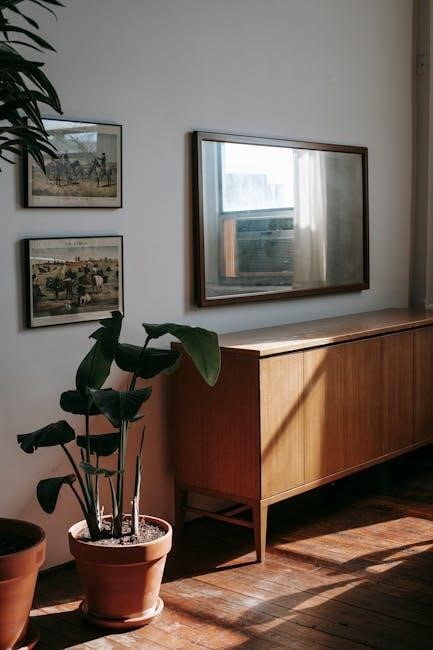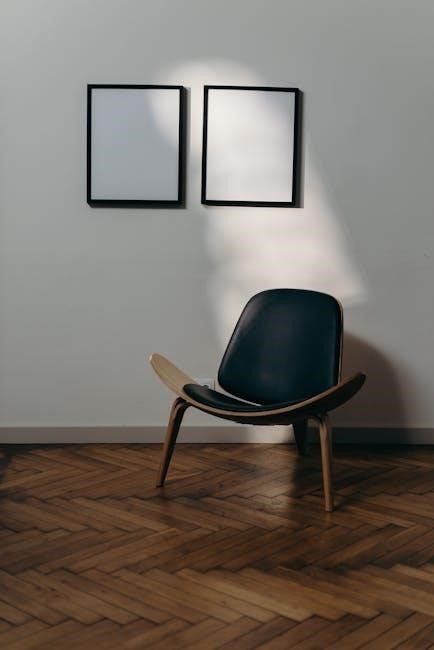Welcome to our comprehensive wall art size guide, designed to help you choose the perfect dimensions for your space. Whether you’re decorating a small room or a large wall, this guide provides essential tips and standard sizes in inches to ensure your artwork fits flawlessly, creating a balanced and visually appealing interior design.

Why Wall Art Size Matters
The right wall art size enhances a room’s aesthetics, creating balance and harmony. Incorrect sizing can make a piece feel overwhelming or insignificant, disrupting the space’s visual flow.
Importance of Proportions in Interior Design
Proportions play a crucial role in interior design, ensuring harmony between furniture, walls, and decor. Correctly sized wall art maintains balance, preventing spaces from feeling cluttered or empty. Large pieces can make rooms appear larger, while smaller art creates intimacy. The 0.6 to 0.75 rule suggests artwork should cover 60-75% of a wall or furniture’s width. Ceiling height and room dimensions also influence proportions, as taller ceilings allow for larger art. Properly scaled art enhances visual flow, creating a cohesive and inviting atmosphere. Understanding proportions ensures your wall art complements the space, rather than overwhelming or underwhelming it.

Standard Wall Art Sizes
Standard wall art sizes include small (12×16 inches), medium (24×36 inches), large (32×48 inches), and oversized (40×60 inches). These dimensions provide a framework for selecting art that fits most spaces seamlessly.
Small Wall Art Sizes
Small wall art sizes are ideal for intimate spaces or as complementary pieces in larger rooms. Common dimensions include 12×16 inches, 8×12 inches, and 16×24 inches. These sizes are perfect for filling small wall spaces, such as above a side table or in a narrow hallway. They also work well when grouped together to create a cohesive gallery wall. For example, a 12×16-inch piece can add a subtle decorative touch without overwhelming the area. When selecting small art, consider the room’s proportions and the furniture’s scale to ensure a balanced look. Additionally, frames can enhance the overall impact, even in smaller sizes.
Medium Wall Art Sizes
Medium-sized wall art offers versatility and balance, making it suitable for various spaces. Common dimensions include 24×36 inches, 20×30 inches, and 18×24 inches. These sizes are ideal for accentuating furniture like sofas or beds without overpowering the room. A 24×36-inch piece, for instance, can serve as a focal point above a bed or fireplace. Medium-sized art is also great for creating a gallery wall, as it allows for a mix of sizes without overwhelming the space. When choosing medium art, consider the wall’s width and the surrounding decor to ensure harmony. Frames can further enhance the piece, adding depth and style to the overall design.
Large Wall Art Sizes
Large wall art sizes are perfect for making a bold statement in open spaces or larger rooms. Typically ranging from 33 to 40 inches in width and height, these pieces create a striking focal point. A 24×36-inch artwork, for example, is ideal for hanging above a bed, sofa, or fireplace, drawing attention and anchoring the room’s design. Large art is also great for wide, empty walls, offering a polished look that enhances the space. When choosing large art, consider the room’s proportions and the furniture’s scale to ensure balance. Frames can add depth and style, further elevating the piece. Large wall art is a versatile choice for creating a dramatic yet harmonious interior design.
Oversized Wall Art Sizes
Oversized wall art sizes are designed to make a dramatic statement, often starting at 40 inches or larger in width or height. These pieces are perfect for spacious rooms or open-concept areas, as they can fill a large blank wall without overwhelming the space. A common oversized size is 60 inches in height, which draws the eye upward and creates a striking focal point. When choosing oversized art, consider the ceiling height and room proportions to ensure balance. For example, a 40×60-inch piece can anchor a wall above a fireplace or sofa, while larger sizes like 72 inches or more can transform an entire room. Measure your wall and furniture to find the ideal fit, ensuring the artwork enhances the space without dominating it.

Choosing the Right Wall Art Size
To select the perfect wall art size, measure your wall and furniture, then apply the 0.6 to 0.75 rule for proportionate fit. Consider room proportions and personal style for a balanced look.
Guidance for Wall Art Above Sofas and Beds
When selecting wall art for above sofas or beds, ensure it complements the space by following key sizing principles. The artwork should be between 60% to 75% of the furniture’s width, creating a balanced focal point. For example, a sofa that is 84 inches wide should have art that is 50 to 63 inches wide. Large pieces, such as 40×60 inches, work well for making a statement. Position the art so its center is at eye level, approximately 57 to 60 inches from the floor. This ensures visual harmony and draws attention to the piece. Additionally, leave 2 to 4 inches of space above the furniture for a clean, polished look. This approach guarantees your wall art enhances the room’s decor without overwhelming it.
Wall Art Size for Fireplaces
When choosing wall art for above a fireplace, consider the width of the mantel or fireplace surround. A general rule is to select art that is two-thirds to three-fourths of the fireplace’s width. For example, if the fireplace is 48 inches wide, the artwork should be between 32 and 36 inches wide. Large pieces, such as 40×60 inches, work well for grand fireplaces, while smaller spaces may prefer 24×36 inches. Position the art 4 to 6 inches above the mantel for a balanced look. Ensure the piece is proportional to the room’s dimensions and complements the surrounding decor. This sizing ensures the art becomes a focal point without overwhelming the space.
Calculating the Correct Wall Art Size
To determine the ideal wall art size, measure the wall’s width and multiply it by 0.6 and 0.75. This range ensures the artwork is proportional and visually appealing, creating a balanced focal point in any room.
Using the 0.6 to 0.75 Rule
The 0.6 to 0.75 rule is a simple yet effective method for determining the ideal size of wall art. By measuring the width of your wall and multiplying it by 0.6 and 0.75, you can find the optimal width range for your artwork. For example, if your wall is 48 inches wide, the ideal art width would be between 28.8 and 36 inches. This ensures the piece is neither too small nor too large, creating a balanced and harmonious look. Apply this rule to furniture like sofas or beds for cohesive design. Remember, this guideline helps maintain proportions and enhances the overall aesthetic of your space.
Mathematical Approach to Wall Art Sizing
For precise wall art sizing, measure your wall’s width and height. Multiply the wall’s width by 0.6 and 0.75 to determine the ideal art width range. For example, a 48-inch wall yields 28.8 to 36 inches wide. If placing art above furniture, use the furniture’s width instead. Height-wise, large art should be 50-75% of the wall height. This mathematical method ensures proportionate and visually appealing placement, balancing your space effectively with minimal guesswork.

Wall Art Placement Tips
- Hang art at eye level, typically 57-60 inches from the floor for optimal viewing.
- Space multiple pieces 2-4 inches apart for a cohesive, balanced display.
- Center the artwork on the wall, ensuring symmetry for a polished look.
How High to Hang Wall Art
Hanging wall art at the correct height ensures it is visually appealing and functional. A general rule of thumb is to place the center of the artwork at 57-60 inches from the floor, which aligns with average eye level. This height works well for most rooms, allowing the art to be easily viewed by everyone. However, consider the specific context: if the art is above furniture like a sofa or bed, its bottom should be 6-12 inches above the piece. In rooms with higher ceilings, you can hang art slightly higher while maintaining proportion. Always measure the artwork’s height and center it on the wall for a polished look. Step back to ensure it feels balanced in the space.
Spacing Between Multiple Pieces
When arranging multiple pieces of wall art, proper spacing is crucial for a cohesive look. A general rule is to leave 2 to 6 inches between frames, depending on the size of the artwork and the desired aesthetic. Larger pieces may require more space, while smaller ones can be grouped more closely; Start by spacing them 3 inches apart and adjust based on visual balance. Ensure the spacing aligns with the room’s proportions and the artwork’s scale. This approach creates harmony and prevents the wall from feeling cluttered. Always step back to assess the arrangement, making adjustments for a polished, professional display. Proper spacing enhances the overall impact of your wall art collection.
Grouping Wall Art
Grouping wall art can add visual interest and personality to a room. When grouping, mix different sizes and frame styles to create a dynamic display. Start with a unifying theme, such as color palette or subject matter, to maintain cohesion. Space pieces 2 to 6 inches apart, adjusting based on their size and the wall’s proportions. For a balanced look, pair larger artworks with smaller ones, ensuring the arrangement doesn’t feel cluttered. Consider the room’s scale and your personal style to guide the grouping. Use a level to align frames and step back frequently to assess the layout. A well-curated wall art group can become a focal point, enhancing the room’s aesthetic and reflecting your unique taste.

Factors Influencing Wall Art Size
Wall art size is influenced by wall proportions, furniture width, and personal style. Artwork should be 60-75% of the wall or furniture width, considering ceiling height for balance.
Ceiling Height Considerations
Ceiling height significantly impacts wall art size choices. For low ceilings, smaller or medium-sized pieces (20-36 inches) are ideal to avoid overwhelming the space. In contrast, taller ceilings allow for larger art (40-60 inches or more) to create a proportional look. The artwork should generally be placed at eye level, around 57 inches from the floor, ensuring it complements the room’s dimensions. Additionally, the width of the piece should align with the wall or furniture it’s placed above, typically between 60-75% of the width, to maintain harmony and balance in the interior design.
Room Size and Proportions
Room size and proportions play a crucial role in selecting the right wall art. In smaller rooms, opt for wall art sized between 12×18 inches and 24×36 inches to avoid overwhelming the space. Medium-sized rooms can accommodate art ranging from 24×36 inches to 40×60 inches, while larger rooms can showcase oversized pieces, such as 48×72 inches or more. The artwork should complement the room’s scale, ensuring it doesn’t feel too small or overly dominant. Always measure the wall and furniture dimensions to determine the ideal size, aiming for the art to occupy 60-75% of the wall or furniture width it’s placed above. This ensures a balanced and harmonious interior design.
Personal Preference
Personal preference significantly influences wall art size choices. While guidelines provide a framework, individual taste plays a key role. Some prefer minimalist designs with small, delicate pieces, while others opt for bold, oversized art to make a statement. Consider the room’s scale and your style—large art can dominate smaller spaces, while subtle pieces blend seamlessly. Additionally, ceiling height impacts perception; lower ceilings may make large art feel overwhelming. Ultimately, trust your instincts and choose sizes that reflect your aesthetic, ensuring the art enhances the room’s ambiance and aligns with your unique vision. This balance of practicality and personal taste creates a space that truly feels like home.

Examples of Wall Art Sizes
Common wall art sizes include small (12×16 inches), medium (24×36 inches), large (40×60 inches), and oversized (beyond 60 inches). These examples help you visualize and select the right fit for your space, ensuring a harmonious design.
Real-World Applications
In real-world scenarios, wall art sizing plays a crucial role in enhancing interior design. For instance, a 40×60-inch piece is ideal for large spaces, creating a focal point above sofas or fireplaces. Smaller sizes like 24×36 inches work perfectly for statement pieces in cozy rooms. When grouping art, spacing of 2-6 inches between pieces ensures a balanced look. For example, a gallery wall with mixed sizes adds visual interest, while oversized art (beyond 60 inches) commands attention in open areas. Measuring your wall and furniture beforehand ensures the art fits proportionally. Centering the artwork at eye level (around 57 inches from the floor) enhances its impact. These practical applications help you transform any space with the right wall art size.
Selecting the right wall art size is essential for transforming your space into a cohesive and visually stunning environment. By following the guidelines outlined in this wall art size guide, you can ensure that your artwork complements the dimensions of your walls, furniture, and room proportions. Whether you’re working with small, medium, or large pieces, understanding the importance of sizing and placement will elevate your interior design. Remember to measure carefully, consider personal preferences, and use the 0.6 to 0.75 rule for optimal proportions. With these insights, you’ll confidently choose the perfect wall art sizes to enhance your home’s aesthetic and create lasting impressions in every room.

